Human Orbital Spaceflights
![]()
International Flight No. 257STS-124Discovery (35)123rd Space Shuttle missionUSA |
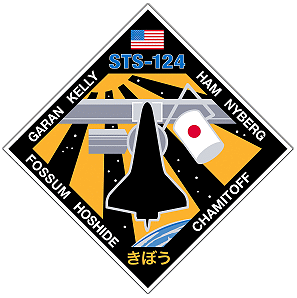 |
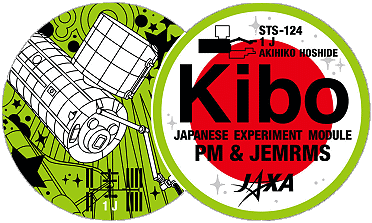 |
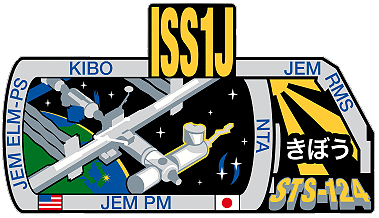 |
||
![]()
Launch, orbit and landing data
walkout photo |
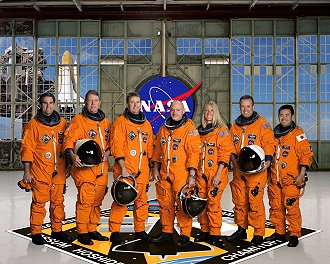 |
|||||||||||||||||||||||||||||||||
alternative crew photo |
alternative crew photo |
|||||||||||||||||||||||||||||||||
alternative crew photo |
alternative crew photo |
|||||||||||||||||||||||||||||||||
alternative crew photo |
||||||||||||||||||||||||||||||||||
Crew
| No. | Surname | Given names | Position | Flight No. | Duration | Orbits | |
| 1 | Kelly | Mark Edward | CDR | 3 | 13d 18h 13m 05s | 217 | |
| 2 | Ham | Kenneth Todd | PLT | 1 | 13d 18h 13m 05s | 217 | |
| 3 | Nyberg | Karen Lujean | MS-1, RMS, JRMS | 1 | 13d 18h 13m 05s | 217 | |
| 4 | Garan | Ronald John, Jr. | MS-2, EV-2, FE, RMS | 1 | 13d 18h 13m 05s | 217 | |
| 5 | Fossum | Michael Edward | MS-3, EV-1, RMS | 2 | 13d 18h 13m 05s | 217 | |
| 6 | Hoshide | Akihiko | MS-4, SSRMS | 1 | 13d 18h 13m 05s | 217 | |
| 7 | Chamitoff | Gregory Errol | MS-5 | 1 | 183d 00h 22m 54s | 2879 |
Crew seating arrangement
|
 |
|
||||||||||||||||||||||||||||||||
Backup Crew
|
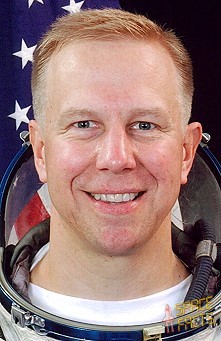 |
Hardware
| Orbiter : | OV-103 (35.) |
| SSME (1 / 2 / 3): | 2051-2 (7.) / 2048-2 (8.) / 2058-2 (3.) |
| SRB | BI-134 / RSRM 102 |
| ET: | ET-128 (SLWT-31) |
| OMS Pod: | Left Pod 01 (38.) / Right Pod 03 (36.) |
| FWD RCS Pod: | FRC 3 (35.) |
| RMS: | 202 (11.) |
| EMU: | EMU No. 3015 (PLSS No. 1015) / EMU No. 3017 (PLSS No. 1017) |
Flight
|
Launch from Cape Canaveral (KSC) and
landing on Cape Canaveral (KSC), Runway 15. Stephen Bowen was originally assigned to STS-124 but was moved to STS-126 to allow this mission to rotate an ISS crew member. Stephen Bowen was scheduled to perform the EVAs on the flight along with Michael Fossum. Ronald Garan took his place for the EVAs. STS-124 (ISS-1J JEM PM JEM RMS) delivered the Pressurized Module (JEM PM) of the Japanese Experiment Module (JEM), called Kibo, to the International Space Station (ISS). Kibo was berthed to the Harmony module and the pressurized section of the JEM Experiment Logistics Module, brought up by the STS-123 crew, was moved from Harmony to the JEM PM. The Japanese Remote Manipulator System, a robotic arm, was also delivered by STS-124 and attached to Kibo. The entire Kibo laboratory is being brought up over three missions. Gregory Chamitoff replaced Garrett Reisman who arrived on the station in March 2008 and was completing three months as a station Flight Engineer. Garrett Reisman returned to Earth aboard Discovery. Gregory Chamitoff returned to Earth on shuttle mission STS-126, while Sergei Volkov and Oleg Kononenko returned in Soyuz TMA-12 in October 2008. Kibo is 14 feet (4.3 meters) longer than Columbus and 9 feet (2.7 meters) longer than the U.S. Destiny laboratory. It joins the first component of the Japanese segment of the station, the Experiment Logistics Module-Pressurized Section (JEM ELM PS), that was launched on the last shuttle flight, STS-123, in March 2008. The logistics module will be robotically detached from the top port of Harmony during the mission and reattached to the top port of Kibo to serve as a storage depot. The JEM ELM PS was launched with eight racks of science gear and control equipment that will be transferred to the JPM for installation. In all, Kibo can house up to 23 racks of equipment and experiments that will involve research in space medicine, biology, Earth observations, materials production, biotechnology and communications. The new pressurized module also is equipped with its own robotic manipulator system and an airlock. The Japanese robotic device will be comprised of two separate six-jointed arms, the main arm that measures 32.5 feet (9.9 meters) and can handle up to seven tons of hardware, and a small fine arm, a 6.2-foot (1.9 meter) extension that will be used for delicate payload operations. The small fine arm will be launched later on a new Japanese resupply ship for the station called the H-II Transfer Vehicle (HTV). The airlock ultimately will be used once the final components for the Japanese segment of the station are delivered on shuttle mission STS-127. That flight will install the Exposed Facility (JEM EF) and the Exposed Logistics Module - Exposed Section (JEM ELM-ES). Some experiments will be mounted on a sliding platform that will move out of the depressurized airlock and handed off to the small fine arm for installation onto the exposed section. The airlock is not designed for spacewalks. One of the trenches at launch pad 39-A that channels flames away from the shuttle during lift-off was significantly damaged. The subsequent mishap investigation found that the damage was the result of carbonation of epoxy and corrosion of steel anchors which held the refractory bricks in place. These had been exacerbated by the fact that hydrochloric acid is an exhaust by-product of the solid rocket boosters. During the first full day in space, Kenneth Ham and Karen Nyberg completed a limited inspection of the shuttle’s thermal protection system using the end effector camera of the shuttle’s robotic arm. The crew also installed the centerline camera and extended the orbiter’s docking system ring to prepare Discovery' for arrival at the space station. Rendezvous began with a precisely timed launch of the shuttle on its trajectory for its chase of the International Space Station. A series of engine firings over the next two days brought Discovery to a point about 50,000 feet (15,240 meters) behind the station. Once there, Discovery started its final approach. About 2.5 hours before docking, the shuttle's jets were fired during what is called the terminal initiation burn. Discovery covered the final miles to the station during the next orbit. As Discovery moved closer to the station, the shuttle's rendezvous radar system and trajectory control sensor gave the crew range and closing-rate data. Several small correction burns placed Discovery about 1,000 feet (304.8 meters) below the station. Commander Mark Kelly, with help from Pilot Kenneth Ham and other crew members, manually flew the shuttle for the remainder of the approach and docking. Mark Kelly stopped Discovery about 600 feet (182.9 meters) below the station. Once he determined there is proper lighting, he maneuvered Discovery through a nine-minute back flip called the Rendezvous Pitch Maneuver and known as R-bar Pitch Maneuver (RPM). That allowed the station crew to take as many as 300 digital pictures of the shuttle's heat shield. Station crew members used digital cameras with 400 mm and 800 mm lenses to photograph Discovery's upper and bottom surfaces through windows of the Zvezda Service Module. The 400 mm lens provided up to 3-inch (7.6 centimeters) resolution and the 800 mm lens up to 1-inch (2.5 centimeters) resolution. The photography was one of several techniques used to inspect the shuttle's thermal protection system for possible damage. Areas of special interest included the thermal protection tiles, the reinforced carbon-carbon of the nose and leading edges of the wings, landing gear doors and the elevon cove. The photos were downlinked through the station's Ku-band communications system for analysis by systems engineers and mission managers. When Discovery completed its back flip, it was back where it started, with its payload bay facing the station. Mark Kelly then flew Discovery through a quarter circle to a position about 400 feet (121.9 meters) directly in front of the station. From that point he began the final approach to docking to the Pressurized Mating Adapter 2 at the forward end of the Harmony node. The shuttle crew members operate laptop computers processing the navigational data, the laser range systems and Discovery's docking mechanism. Using a video camera mounted in the center of the ODS, Mark Kelly lined up the docking ports of the two spacecraft. He paused 30 feet (9.14 meters) from the station to ensure proper alignment of the docking mechanisms. He maintained the shuttle's speed relative to the station at about one-tenth of a foot per second (3 centimeters per second), while both Discovery and the station were moving at about 17,500 mph (28,163 km/h). He kept the docking mechanisms aligned to a tolerance of three inches (7.6 centimeters). When Discovery made contact with the station on June 02, 2008, preliminary latches automatically attached the two spacecraft. The shuttle's steering jets were deactivated to reduce the forces acting at the docking interface. Shock absorber springs in the docking mechanism dampened any relative motion between the shuttle and station. Once motion between the shuttle and the station had stopped, the docking ring was retracted to close a final set of latches between the two vehicles. A few hours after Discovery's docking on the third day of the flight, Gregory Chamitoff and Garrett Reisman exchanged custom-made Russian Soyuz spacecraft seat liners. With that exchange, Gregory Chamitoff became a part of the Expedition 17 space station crew and Garrett Reisman became part of Discovery's crew. Gregory Chamitoff joined expedition Commander Sergei Volkov and Flight Engineer Oleg Kononenko who were launched to the complex in the Soyuz TMA-12 spacecraft on April 08, 2008 from the Baikonur Cosmodrome in Kazakhstan. Following a standard safety briefing by station Commander Sergei Volkov, the crews will get to work, activating the Station to Shuttle Power Transfer System (SSPTS) to provide additional electricity for the longer operation of shuttle systems. Discovery carried with its replacement parts in a mid-deck locker for a malfunctioning toilet on the International Space Station. The crew had been using other facilities for waste until the new replacement parts were installed on the Zvezda module of the ISS. The first EVA was performed by Michael Fossum and Ronald Garan on June 03, 2008 (6h 48m) to transfer of the Orbiter Boom Sensor System back to the shuttle from its temporary location of the station's truss, or backbone. The crew then prepared the JEM PM for its removal from the shuttle's payload bay. Later that day, the JEM PM was installed on the port side of Harmony. The first objective was to transfer the OBSS left after the previous shuttle mission from the station's truss to space shuttle Discovery. Most of the tasks fall to Ronald Garan, who was releasing the stanchions holding the boom to the truss and removing a bag that had protecting the boom's sensor package. Just before the station's robotic arm took control of the boom and handed it off to the shuttle's robotic arm, Michael Fossum detached the keep-alive umbilical that has been providing the boom's systems with power while stowed. The boom was used later in the mission to inspect the shuttle's heat shield. Next, the spacewalkers prepared the Kibo laboratory for installation. While Ronald Garan was working on the boom, Michael Fossum inspected the Harmony Node's left side active common berthing mechanism to ensure that it's ready to attach to Kibo. He also opened a window cover to provide the crew inside with a good view of the installation. After the boom work was done, Ronald Garan and Michael Fossum worked together in the shuttle's cargo bay to remove contamination covers from the surface where the module will connect to Harmony. Michael Fossum also disconnected the heater cables connecting the module to the shuttle and removed three bolts that lock the shutters of Kibo's forward window in place for launch. The spacewalkers' final tasks of the spacewalk took them to the station's starboard solar alpha rotary joint. The 10-foot-wide (30.5 meters) rotary joint, which allows the station's starboard solar arrays to rotate and track the sun, began experiencing increased vibration and power usage in the fall of 2007. Inspections turned up metal shavings inside the joint. One of the joint's 12 trundle bearing assemblies, which allow the joint's outboard ring to rotate around its inboard ring, was removed. Ronald Garan installed a replacement for that trundle bearing assembly. Meanwhile, Michael Fossum inspected a potentially damaged area on the joint to determine whether there was debris sitting on the surface of the metal, or a divot in the metal. A similar inspection was performed during STS-123, but Michael Fossum used sharper tools to give him more tactile feedback. Michael Fossum also tried out techniques for cleaning the surface of the joint's race ring. First, he tried removing a section of the debris, using a putty knife as a scraper. Next, he applied grease to the surface and then tried the scraper again. And finally, Michael Fossum tried using a wipe and grease. On flight day 5 the hatch to the Kibo lab was opened at 21:05 UTC. The crew also repaired the malfunctioning ISS toilet. The second EVA by Michael Fossum and Ronald Garan occurred on June 05, 2008 (7h 11m) to install covers and external television equipment on the JEM PM and remove covers on the JEM RMS, which was later installed on flight day 8. The spacewalkers also prepared for the flight day 7 relocation of the Japanese logistics module. The crew began the second spacewalk by installing on the Kibo laboratory two cameras that will be used to judge clearances for the module's robotic arm. Ronald Garan installed the forward camera, while Michael Fossum worked on the aft. They then worked together to remove the seven thermal covers on each of the robotic arms' six joints and its end effecter. Each cover required the spacewalkers to remove two fasteners and disconnect two grounding wires. Next, they prepared the laboratory's top active common berthing mechanism for the attachment of a smaller section of the module, the JLP, which was delivered during STS-123. To do so, they removed the berthing mechanism's thermal cover, the bolts securing two micrometeoroid orbital debris shields and a launch lock, and inspected its surface. They also installed thermal covers on the metal post that connected the laboratory to the shuttle's cargo bay. After that, Ronald Garan and Michael Fossum split up to prepare for a nitrogen tank assembly swap that they performed on the mission's third spacewalk. The nitrogen tank assembly uses high-pressure nitrogen gas to control the flow of ammonia out of the ammonia tank assembly. Ammonia is used to control the temperature on the station's exterior. Michael Fossum moved to the left side of the station's truss, where a spare nitrogen tank assembly was located on External Stowage Platform 3. He installed an articulating portable foot restraint onto the platform for use during the next spacewalk, and loosened the four bolts that anchored the nitrogen tank assembly to the platform. And to prevent overheating during the swap, he installed thermal covers over the assembly's quick disconnect lines. Ronald Garan also loosened the bolts and installed thermal covers on the old nitrogen tank assembly, which was on the starboard truss. In addition, he disconnected three electrical connections and the nitrogen lines that attached the assembly to its corresponding ammonia tank assembly. For the final tasks of the spacewalk, Ronald Garan joined Michael Fossum on the left truss to remove an external television camera that had a failing power supply. They brought the camera inside with them, where the power supply was replaced, and then reinstalled it during the third spacewalk. The crew moved the Kibo Logistics Module from Harmony to the Pressurized Module on flight day 7. On flight day 8 Akihiko Hoshide and Karen Nyberg moved two of the six joints on the Japanese Kibo lab's robotic arm for the first time, maneuvering them very slightly with a series of commands. The third and final EVA by Michael Fossum and Ronald Garan was conducted on June 08, 2008 (6h 33m) to replace a failed nitrogen tank assembly on the station's truss with a spare. That was temporarily stored on one of the station external stowage platforms. They also retrieved a failed camera system on the truss. Replacing the depleted nitrogen tank assembly required Ronald Garan to spend much of his third spacewalk on the station's robotic arm. He started the spacewalk by installing a width extender to increase the robotic arm's reach, climb into a foot restraint attached to the width extender and remove four bolts holding the old nitrogen tank assembly in place on the starboard truss. After installing a handle on the assembly, he removed it from the truss and carried it to the external stowage platform, via the robotic arm. Meanwhile, Michael Fossum removed the spare nitrogen tank assembly from the platform to make room for the old one, and stored it on the other side of the platform. When Ronald Garan arrived with the old assembly, Michael Fossum guided it into place and began securing it to the platform with four bolts. Once one of the four bolts was secured, Ronald Garan removed his handle from the old assembly, attached it to the new one and rode the robotic arm back to the starboard truss with the nitrogen tank assembly in tow. He removed his handle, installed the bolts to secure it to the truss and connected the necessary electrical link. Then he got off the robotic arm and moved to the back of the truss to connect the assembly's nitrogen lines to the ammonia tank assembly. Meanwhile, Michael Fossum finished securing the old nitrogen assembly and moved to the Kibo module to finish outfitting it. He removed launch locks and thermal covers from the two cameras on the module's robotic arm, as well as the launch locks on the module's aft window. The window had been blocked by the robotic arm during the first spacewalk, when he removed the launch locks on the module's forward window. He then deployed two micrometeoroid debris shields on either side of the connection between the larger laboratory module and the recently relocated experiments logistics module. Once that was done, Michael Fossum returned to the airlock to retrieved the external television camera with its new power supply. He met Ronald Garan back on the port truss, where they reinstalled the camera. On June 09, 2008 Kibo's robot arm was extended to its full 33 feet (10 meters), with all six joints tested. The astronauts also opened the hatch to the Kibo's storage unit. At undocking time, the hooks and latches were opened, and springs pushed the shuttle away from the station. Discovery's steering jets were shut off to avoid any inadvertent firings during the initial separation. Once Discovery was about two feet (61 centimeters) from the station and the docking devices were clear of one another, Kenneth Ham turned the steering jets back on and manually controlled Discovery within a tight corridor as the shuttle separated from the station. Discovery moved to a distance of about 450 feet (137.2 meters), where Kenneth Ham began to fly around the station in its new configuration. Once Discovery completed 1.5 revolutions of the complex, Kenneth Ham fired Discovery's jets to leave the area. The shuttle moved about 46 miles (74 km) from the station and remained there while ground teams analyzed data from the late inspection of the shuttle's heat shield. The distance was close enough to allow the shuttle to return to the station in the unlikely event that the heat shield is damaged, preventing the shuttle's safe re-entry. Just prior to the landing the decision was made to use runway 15 rather than 33. This decision was made based on the sun glare that would be present on the Commander's window as he lined up Discovery with the runway. |
EVA data
| Name | Start | End | Duration | Mission | Airlock | Suit | |
| EVA | Fossum, Michael | 03.06.2008, 16:22 UTC | 03.06.2008, 23:10 UTC | 6h 48m | STS-124 | ISS - Quest | EMU No. 3015 |
| EVA | Garan, Ronald | 03.06.2008, 16:22 UTC | 03.06.2008, 23:10 UTC | 6h 48m | STS-124 | ISS - Quest | EMU No. 3017 |
| EVA | Fossum, Michael | 05.06.2008, 15:04 UTC | 05.06.2008, 22:15 UTC | 7h 11m | STS-124 | ISS - Quest | EMU No. 3015 |
| EVA | Garan, Ronald | 05.06.2008, 15:04 UTC | 05.06.2008, 22:15 UTC | 7h 11m | STS-124 | ISS - Quest | EMU No. 3017 |
| EVA | Garan, Ronald | 08.06.2008, 13:55 UTC | 08.06.2008, 20:28 UTC | 6h 33m | STS-124 | ISS - Quest | EMU No. 3017 |
| EVA | Fossum, Michael | 08.06.2008, 13:55 UTC | 08.06.2008, 20:28 UTC | 6h 33m | STS-124 | ISS - Quest | EMU No. 3015 |
Note
Photos / Graphics
 |
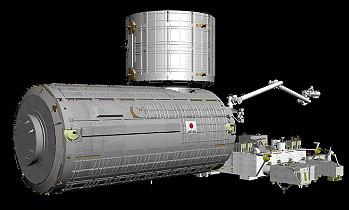 |
 |
 |
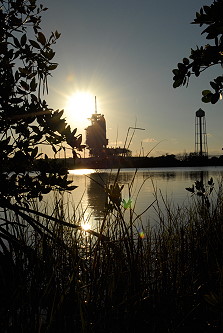 |
 |
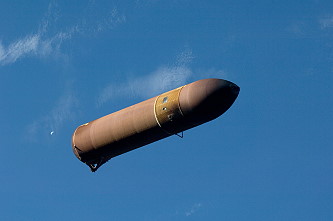 |
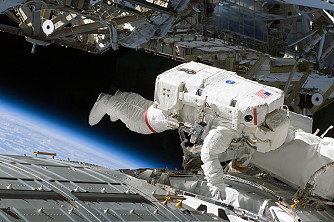 |
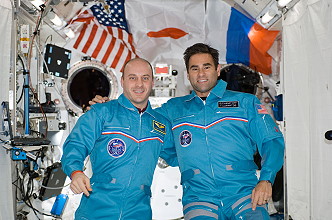 |
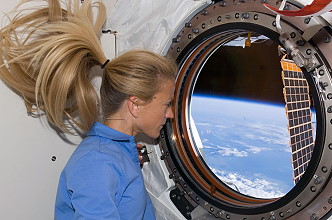 |
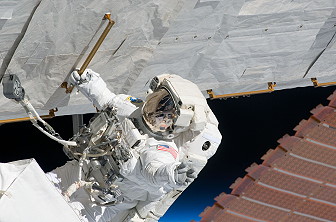 |
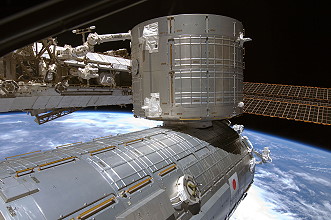 |
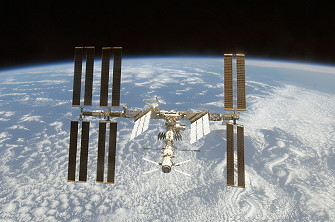 |
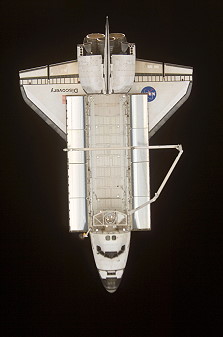 |
 |
 |
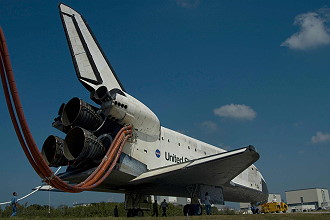 |
|
more EVA photos |
|
| © |  |
Last update on March 27, 2020.  |
 |